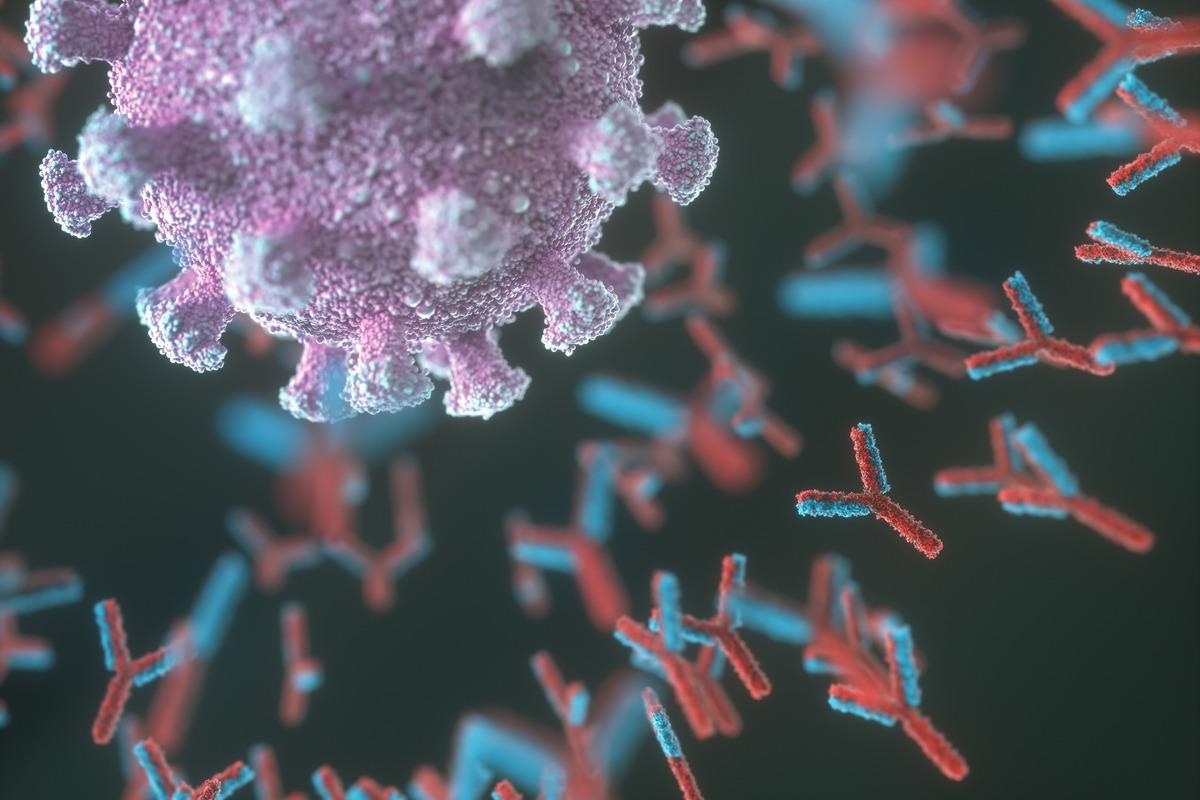In a recent study published in the PLOS Pathogens journal, researchers assessed the proportion of receptor-binding domain (RBD) antibodies in coronavirus disease 2019 (COVID-19)-recovered patients.

Accurate evaluation of antibody responses against the severe acute respiratory syndrome coronavirus 2 (SARS-CoV-2) antigens is essential to ascertain the history of viral exposure and assess viral transmission in the community. Hence, it is important to understand the longitudinal kinetics of antibody responses after COVID-19 recovery to estimate the robustness of serological memory.
About the study
In the present study, researchers performed a longitudinal study of alterations in RBD+ antibody levels in COVID-19-recovered patients up to 450 days after the symptom onset.
The team investigated the longitudinal kinetics and the persistence of SARS-CoV-2-specific antibodies by studying a cohort of 192 individuals who reported recovery from COVID-19. COVID-19 diagnosis was based on a positive quantitative polymerase chain reaction (qPCR) for SARS-CoV-2. The number of days following symptom onset (DFS) was set as per the duration reported by the participants.
The study included a sub-cohort of COVID-19-recovered patients, including 18 patients who had received one dose of the BNT162b2 COVID-19 messenger ribonucleic acid (mRNA) vaccine within a duration of 222 DFS. Another prospective cohort included in the study comprised 17 naive individuals vaccinated with two doses of the BNT162b2 vaccine with a duration of 21 days between the two doses. Samples from this group were collected eight days after the first dose vaccination (DFVx1) and at four visits conducted eight, 35, 91, and 182 days after the second dose vaccination (DFVx2).
The team measured RBD+ immunoglobulin G (IgG), IgM, and IgA levels via semi-quantitative enzyme-linked immunosorbent assay (ELISA). The levels of antibodies at RBD+ were categorized at the first follow-up visit (V1) to assess the correlation between the robustness of the antibody response post-SARS-CoV-2 infection and the age and gender of the patient and disease severity.
Serum samples obtained from the COVID-19 recovered patients were used to estimate the robustness of the RBD+ antibodies over 14 months. The team explored the correlation between the time of symptom onset and RBD+ levels of IgG, IgA, and IgM. Furthermore, the longitudinal kinetics of the antibodies was estimated by calculating the antibody titers of the RBD+ antibodies in follow-up samples obtained from recovered patients.
Results
The study cohort had a median age of 53 years, comprising 49.2% females, with 83% reporting mild and 17% moderate to severe disease severity. After the second vaccination, the team collected a total of 192 samples from COVID-19 recovered persons in V1 and 95 samples between V2 and V4. Furthermore, 61 samples were collected from the group comprising recovered and vaccinated persons, while 68 samples were obtained from naive vaccinees.
Assessment of the association of age, gender, and disease severity with antibodies produced showed that the IgG and IgG levels differed substantially between the female and male participants. When the study cohort was classified by patients aged 60 years and lesser and more than 60 years, the IgG and IgG isotypes were higher in the patients aged more than 60 years, while no such variation was found with respect to IgM levels. Furthermore, disease severity during the active phase of the infection was correlated to higher IgA and IgG levels at V1.
The team also found that for all the antibody isotypes, the levels of RBD+ decayed over the study period of 14 months. The decay of IgG RBD+ antibody levels were observed in 18.4% of the samples, IgA in 61.81%, and IgM in 54.86%. Furthermore, the generalized additive mixed model (GAMM) analysis showed the two-phase decay profile of IgG while IgA and IgM had an almost linear regression profile. Overall, the variation between the decay rates showed that the decay rate of IgG was significantly faster than that of IgA.
The longitudinal kinetics of the RBD+ antibodies showed a significant decay of the antibody levels in all the follow-up samples obtained from COVID-19 recovered patients. At V1 and V4, the number of patients who had antibody titers that were within the threshold of the negative control was 19.8% and 27.3% for IgG, 61.4% and 77.3% for IgA, and 50.5% and 74.2% for IgM. Furthermore, the GAMM analysis showed that IgA had the fastest decay rate compared to IgG and IgM.
Conclusion
Overall, the study findings highlighted the differences in the robustness exhibited by RBD+ antibodies among COVID-19-recovered patients and naive individuals. The researchers believe that the present study can help improve the vaccination policies to combat the COVID-19 pandemic.
- Eyran, T. et al. (2022) "Longitudinal kinetics of RBD+ antibodies in COVID-19 recovered patients over 14 months", PLOS Pathogens, 18(6), p. e1010569. doi: 10.1371/journal.ppat.1010569. https://journals.plos.org/plospathogens/article?id=10.1371/journal.ppat.1010569
Posted in: Medical Science News | Medical Research News | Disease/Infection News
Tags: Antibodies, Antibody, Assay, Coronavirus, Coronavirus Disease COVID-19, covid-19, Enzyme, Immunoglobulin, Pandemic, Polymerase, Polymerase Chain Reaction, Receptor, Respiratory, Ribonucleic Acid, SARS, SARS-CoV-2, Severe Acute Respiratory, Severe Acute Respiratory Syndrome, Syndrome, Vaccine

Written by
Bhavana Kunkalikar
Bhavana Kunkalikar is a medical writer based in Goa, India. Her academic background is in Pharmaceutical sciences and she holds a Bachelor's degree in Pharmacy. Her educational background allowed her to foster an interest in anatomical and physiological sciences. Her college project work based on ‘The manifestations and causes of sickle cell anemia’ formed the stepping stone to a life-long fascination with human pathophysiology.
Source: Read Full Article





